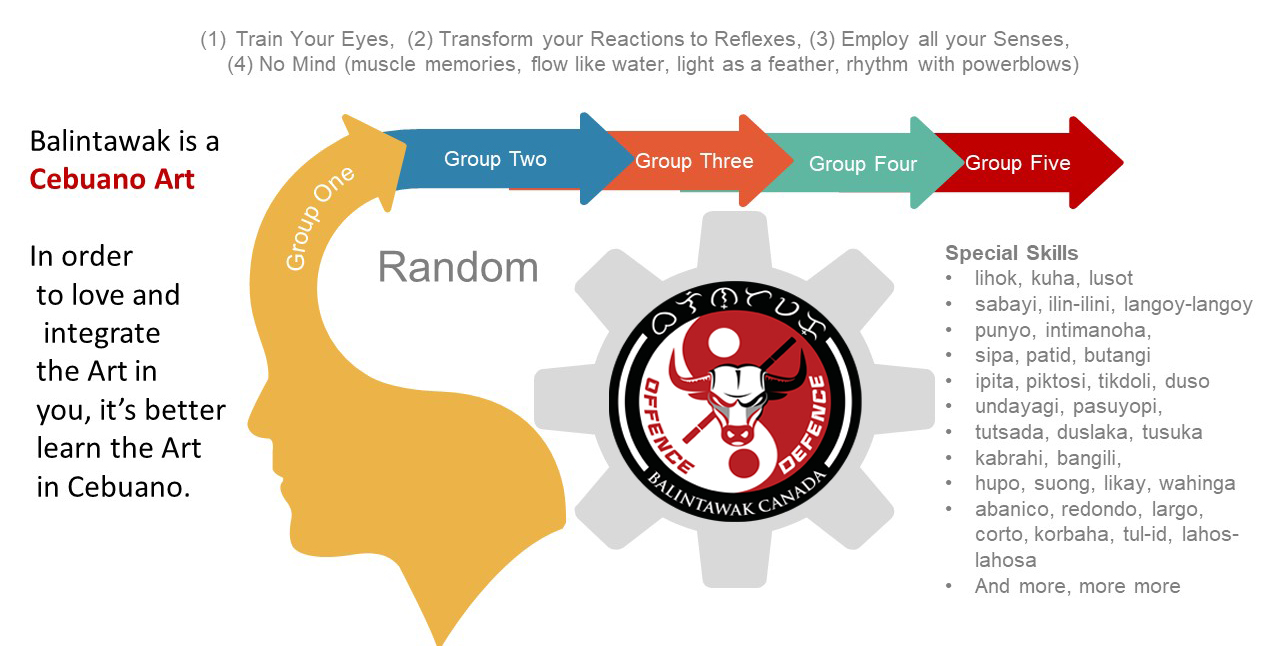
Balintawak Fundamentals
"Higug-maa ni kay atoa kini!"
In a play as well as in a fight, I firmly believe that there are 4 essential interconnected process. 1.) Plastada (setup, layout), 2.) Lihok (move) 3.) Kuha (special skills or technique) 4.) Lusot (Execution, or way out). Nevertheless, I always encounter serious problems in translating these Cebuano words. That's why it's better to teach Balintawak in our native medium of communication, our Cebuano language.
This process is synonymous to a network. All 4 is dynamically linked to each other. If the setup is poor, the rest will suffer its domino effect consequences. If your setup is right, but your kuha is poor, the outcome will not be that effective. That is why our predecessors have arranged the series of attacks into 5 Groupings to teach us the methodic way of gradual and systematic way of learning Balintawak.
In Close Quarter or Corto Distance fighting, "Simhota ko Dong!" "Smell or Sniff me!" "Suyopi" "Draw your opponent in", "undayagi", "ilin-ilini ug sabayi", "dakdaki ug tagaki lang gud" are old Cebuano expressions (so hard to translate in English) used during agak and palakaw drills. For every old school practicioner, it is very explicit that Balintawak is intensely a close quarter combat art with "single stick" as the sole eskrimador's held weapon. To learn more, ask your nearest Balintawak Instructor or contact us...
"Ayaw pag una kay maulahi ka, mas maayo pang maulahi ka kay makaapas ka pa!" GM Monie Velez once asked me, "When you drive, do you muscles tense up, or do you choke the steering wheel or raise your elbows?" Like driving, every decision-making that you do is a matter of life and death. So refrain from anticipating. To learn well, your eyes have to be laser-beam focus to your opponent. If you're not relax, speed will never be on your side.
As you "AGAK", you will gradually understand your basic lessons and improve your skills. So relax, be humble by giving yourself this lifetime chance, and be coachable.
Guro Rolly VillaTo advance, you must first be BRILLIANT WITH YOUR BASICS
01. Learn our Etiquettes
1. Pre-register online before and arrive early. If the Dojo is in session, please sit at the bench and observe proper protocols. 2. Pagpupugay - "Osu" and Balintawak bow 3. Essential Hygiene (Shower before practice, wear deodorant if you can.) 4. Always wear your uniform or T-Shirt. 5. Safety first. Cut your nails and no clutter of practice weapons. 7. Just leave if you can't be in harmony with anyone.
02. THE WAY OF THE STICK
1. Oftentimes, treat your stick as a stick but still keep in mind, it can also be a bladed weapon. 2. Master your weapon and its different parts 3. Adapt good habits and obey your teacher 4. Learn and adapt the "Forms" for the right placements and maneuverings of your stick.
03. THE ART OF HITTING
As in a dance, Balintawak is versatile and elegant. Brutal force is not its usual ally. When in motion, the best offense is defense while the best defense is offense. Timing is everything.
04. BALANCE AND FOOTWORKS
At offense, the balance could be 40/60. At defense, it is 60/40. Except in groupings, where the stick is, the foot is positioned forward as a fighting stance.
05. LEARN 12 BASIC STRIKES (7 HITTING; 5 THRUSTINGS).
Knowing the exact zones, learn precise target hitting and control. With body movements and footworks, learn correct form of handling the stick, maneuvering and execution of the strike.
06. CHARACTER AND PERSISTENCY ARE EVERYTHING!
How hungry are you to learn? Do you take notes? Are you a good listener? Have you established some practice routines? What's your game plan in life?
LESSON PLAN 2025
a BLUEPRINT in building our Balintawak Canada project.
- JANUARY
--- No Class ---
- FEBRUARY
* How to Bow and some Dojo Etiquettes
* Train the eyes, hand, body movements, and footwork coordination
* Exercises - Flexibility, Breathing, Forms, and Kata (Offense and Defense)
* The Art of Holding the Stick, and its functional Parts
* Learning and adapting proper forms
* Undayag and Duyan-duyan - role of timing
* Training the Wrists - Arms - Elbows - Shoulder flexibility, Hips, Knees, and pivoting coordination<br>
* Balance (50/50, 60/ 40) and regular checking<br>
* Principle of Footworks, cuentada eye, and some lansis or tricky bluff
- MARCH
* Sinawali Drills (preparatory drills for either stick, mano-mano)
* On Balance, Undayag, mechanics of offense and defense.
* Different implications of Triangle Footworks
* Strikes - 12 Basic and Power Strikes
* Shadow Fighting - Strikes 1 to 12 Basic Defense and Offense (Kata Form)
* Quadrant Targeting in different fighting levels - windows of opportunity in heaven, in the center, and on earth
* Learning Proximity - variable ranges in fighting
* the Powerblow Strikes
- APRIL
Intro to Group # 1
* Emphasis on Undayag as integral to special skills
* Intro to Holding, lifting, elbow placement, and stick hitting
* Intro to pushing - distance checking and flexibility
* Intro to left-right coordination - punching and slapping, clipping and elbow
* Intro to managing - setup for disarm, punching, locking, etc
* Intro to thumb judo, elbow breaking, locking, throwing, etc
* Intro to Group 2 with emphasis on head movement and pungo, pukpok, gasgas
- MAY -- Friend to Friend Saturday
Intro to Group # 2 - Mastery of the Other End of the Stick - The Butt
* Emphasis on Head Movement, "Hupo", "Wahing", "Punyo", "Pukpok", "Gasgas"
* Lifting and Clearing with Butting Defense even with Elbow
* defense and counter against butting attacks
* Intro to different hitting (redondo, otso-otso, tutsada, saltada, abanico, witik, dagit, labtik, latos)
* Basic Set-up, Application, Execution, Sequence, Variations, Test
- JUNE -- The Art of Palakaw
Intro to Group # 3 - Master of the Opposite End of the Stick - Thrusting
* Into to Tutsada, Duslak, Luba, Tastas, Banda-banda, Sungkit,
* Intro to Thrusting Defense (sense of proximity - short, mid, long range)
* Intro to Disarm using thrusting, Set-up, Applications, Sequence, Test
* Exploring more Variations
* The Art of Banda-banda
* The Mechanics of Sungkit
* Learning Kulob, Hayang, Luag, Hugot, (protecting the centerline)
- JULY
Group # 4
HITTING - Handling, Cabra, Bangil, Abanico Defense & Offense
* High emphasis on the Left Hand, Pakgang, Checking, Undayag, Fast Movement of the Elbow
* Decisive at the right timing and eyes quick to respond on combative combinations
* Cuentada lansis and economy of moves
- AUGUST
Group # 5 -
* Defense Against Clipping, Pulling, Handling, Holding and Punching
* Emphasis on being relax and more sensitivity
* More Combinations from group 2 so react quickly on head and stomach, center attacks and side strikes,
* Careful on Disarm Tricky Plastada, Lihok, Kuha and Palusot
* Attention to balance, sweeping, stumping, locking and takedowns
- SEPTEMBER
Agak and Palakaw
At this stage, Advance students, who are preparing for Grading, our Future Teachers, we require to have recruited 2 or 3 students
* Extra special training given to future teachers
* Combine all Grouping in Sequence, Random, Broken Drills
and Enhance Special Skills
- OCTOBER
Mastery on How to "Agak" - more palakaw
* Emphasis from No-Touch, Stationery, Free-Wheeling, and Aggressive footworks
* Intense Practice on Hand to Hand Combat and Bladed Weapons
* More special attention trainings to future teachers
- NOVEMBER
Preparing for Grading - More Intense Training
Students must prepare:
- knowledge of code of conduct
- meaning of Cebuano employed words
- explain some words
- principles of Offense and Defense
- history of Balintawak
- fundamentals of Balintawak
- philosophy of Balintawak
- 12 strikes, Kata (defense/counter)
- Forms Checking - explain
- Balance Checking and some surprise questions
- DECEMBER
Proposal Balikatan Event - Grading (Sponsors are welcome!)
* Joint Christmas Party with Aikido Dojo
* Second Saturday of December - 5 Hrs Seminar with GM Ike Sepulveda of Atillo Balintawak (Everyone is welcome)
* No Training from the Third Week on December until the 2nd Week of January.
* First Week of January is a Reset, with New Year's Resolution in mind, a GIGO (Garbage In Garbage Out) and long range planning time.
WHO THIS TRAINING IS FOR
* For all FMA Lovers, not just Balintawak practicioners, and those who are willing to join us in preserving these cultural treasures so our next generation will continue to lavishly enjoy and cherish.
* Because Balintawak Canada is more inclusive and hope to be well-rounded in a sense that we blend "mano-mano" ug "bladed weapon" lessons in our trainings, we tend to have extensive lesson plan that regular normal Balintawak Trainings.
* For achievers who wish to accomplish something that we are all proud to share, enjoy and preserve longer than our lifetime.
* For all the free who loves life, delights on higher gifts life can bestow, and the ones who not could thank enough our supreme creator who nurture this unique martial art through the years.

SEND US A MESSAGE TO SCHEDULE A TRAINING

